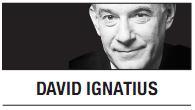WASHINGTON ― As America’s relationship with Pakistan has unraveled over the past 18 months, an important debate has been going on within the U.S. Embassy in Islamabad over the proper scope of CIA covert actions and their effect on diplomatic interests.

The principals in this policy debate have been Cameron Munter, the U.S. ambassador since October 2010, and several CIA station chiefs who served with him. The technical issue was whether the ambassador, as chief of mission, had the authority to veto CIA operations he thought would harm long-term relations. Munter appears to have lost this fight.
The larger issue is the intersection of drone warfare and diplomacy. It’s a crucial question for the Obama administration, which has sharply increased the CIA’s use of these unmanned aircraft to strike at al-Qaida targets in Pakistan, Yemen and Somalia. But there has been relatively little public examination of how these covert weapons should coexist with the goals of statecraft.
In this season of leak investigations, I should make clear that this story didn’t come from either the CIA or from Munter, who has announced that he will leave his post in Islamabad this summer for personal reasons and resign from the Foreign Service. The sources described the Islamabad debate because they believed the issues deserved wider public discussions and understanding.
Munter arrived in Islamabad in 2010 with the difficult challenge of replacing Anne Patterson, a widely admired diplomat who had maintained an easy working relationship with her CIA station chief, John D. Bennett, who in July 2010 became the director of the national clandestine service. Bennett was replaced in Islamabad by a promising younger officer, but the new chief had to be recalled in December 2010 after his cover was blown. The station chief’s name was “outed” by a legal action brought by victims of U.S. drone attacks, but this was almost certainly the work of Pakistani intelligence.
The next station chief arrived in Islamabad Jan. 26, 2011. As it happened, this was one day before a CIA operative named Raymond Davis was arrested in Lahore for killing two Pakistanis. The new station chief, a veteran of operations in Eastern Europe, is said to have argued that the case should be handled by “Moscow rules,” meaning don’t give an inch. Munter initially followed that advice but then began his own discussions with Pakistani authorities.
Munter’s talks with the Pakistanis helped lead to Davis’ release in March 2011, after the payment of “blood money” to the victims’ families under the tribal code. Though Davis was free, the case fueled Pakistani public anger. And the tension within the embassy continued as well. The new chief left in July 2011, partly for health reasons and also because of the personal and policy wrangle with Munter.
As ambassador, Munter had assumed that he had final authority over all activities inside Pakistan that involved the embassy. Patterson had a similar veto power, though it was rarely tested because she and the agency were usually in agreement. But Munter was said to be more wary of the Obama administration’s expansion of drone attacks, fearing that the pace and timing were dissipating long-term U.S. interests in Pakistan for short-term counterterrorism gains.
The strains in the U.S.-Pakistani relationship became acute after the May 2 attack on Abbottabad that killed Osama bin Laden. So did the intra-embassy dispute about drones. Munter is said to have supported “high-value target” strikes on named individuals, and “imminent threat” strikes to stop, say, a car bomb. But he questioned the cost-benefit ratio for some so-called “signature” strikes, where the name of the target isn’t known. Sometimes these strikes produce a bonanza, as in the June 2011 signature attack that killed Ilyas Kashmiri, one of al-Qaida’s most dangerous operatives.
The issue of ambassadorial veto power was kicked upstairs; the State Department now has a formal consultative role, but in the case of a dispute, final authority rests with the top of the chain of command in any covert action, which is the president and the CIA director. But interestingly, Director David Petraeus is said to have sided often with Munter, sharing his view that the long-term costs of drone attacks in Pakistan sometimes outweighed the short-term gains. Petraeus’ skepticism is said to have strained his relations with the chief of the CIA’s counterterrorism center.
I described Obama last year as “covert commander in chief,” and he obviously has relished this role. But he needs to remember that he’s diplomat in chief, too.
By David Ignatius
David Ignatius’ email address is davidignatius@washpost.com. ― Ed.
(Washington Post Writers Group)








